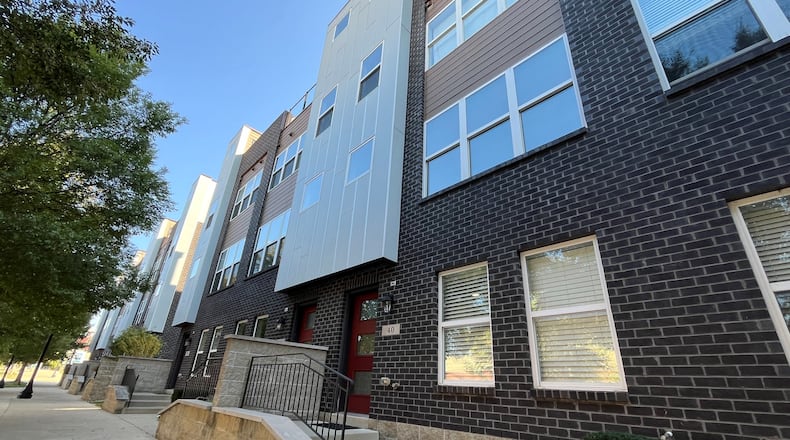“We feel that this CRA will help induce investment in an area very much in need of such,” said Tony Kroeger, Dayton’s planning division manager. “Anecdotally, I will share that CRAs are often a key piece to the feasibility of a housing development.”
What are Community Reinvestment Areas
The Dayton City Commission recently had the first reading of an ordinance that would repeal and replace two Community Reinvestment Areas (CRAs) in west Dayton that were approved in 2016.
The proposed “West CRA” would cover all of the city south and west of the Wolf Creek waterway and the Great Miami River. Combined with an existing CRA in northwest Dayton, everything west of the Stillwater River and the Great Miami River would be in a CRA.
CRAs are areas in which property owners can receive tax incentives for building new structures or remodeling existing properties.
The proposed West CRA would offer 100% property tax abatements for 15 years on the increased value of new residential buildings or residential properties that are remodeled.
For example, if the owner of a $50,000 home in a CRA spent $100,000 on a new addition, for 15 years, they could continue paying property taxes as if the property was still worth $50,000. The increased value would not be taxed in those 15 years.
If a homebuilder constructed a new home on an empty lot in a CRA, the property could continue to be taxed for a decade and a half as no home was built there.
Additionally, new commercial and industrial buildings and existing buildings that are renovated also would be eligible for tax abatements worth up to 100% of the value of the improvements for 15 years.
However, the final terms must be negotiated and approved in a CRA agreement. CRA commercial or industrial projects require school board approval if they propose to exempt more than 75% of the project’s value.
In Ohio, public school districts are the largest recipients of property tax revenues in nearly all communities. Dayton is no different, according to Montgomery County auditor data, with more than half of property taxes going to Dayton Public Schools, followed by sizeable chunks to the city of Dayton and Montgomery County, and smaller amounts to Sinclair College, Dayton Metro Library and Five Rivers MetroParks.
Dayton schools Superintendent David Lawrence said the school district has a strong partnership with the city and leaders meet bi-monthly to discuss matters like tax incentive programs.
“We will continue to engage in these discussions and are confident that it will ultimately lead to decisions being made in the best interest of the city as a whole, including DPS,” Lawrence said about the proposed CRA expansion.
By the numbers and dollars
Last year, there were about 192 residential properties and 29 commercial and industrial properties in Dayton that benefitted from CRA tax abatements.
The total investment put into those residential CRA properties exceeded $194 million. The combined commercial and industrial investment by CRA properties was in the hundreds of millions of dollars.
Keith Kline, an economic development specialist with the city, said investors can use their annual property tax savings from the CRA program to help pay off construction loans that otherwise might be a major financial burden.
“Once the CRA expires, the property tax returns to normal,” he said. “By then, the investor has paid off the construction loan or they built up enough equity to refinance the loan if necessary.”
CRA tax abatements have benefited projects in the Water Street District around the Dayton Dragons stadium; the revitalization of the Dayton Arcade; the construction of a new facility for Economy Linen and Towel Service in West Dayton; and the Flats at South Park apartments.
Credit: Tom Gilliam
Credit: Tom Gilliam
Geography
Existing west and innerwest CRAs and one other CRA that spills over into the west geography cover about 4.3 square miles, said Kroeger, Dayton’s planning division manager.
Kroeger said the new West CRA would be about four times that size, covering more than 16 square miles.
Right now, Dayton has 14 CRAs that combined cover about 16 square miles of the city, Kroeger said. Dayton’s total area is about 56 square miles.
Last fall, the city replaced several CRAs in northwest Dayton with a much larger one that covers about 18 neighborhoods. Other cities, including Columbus and Toledo, have fairly recently decided to practically make their entire cities CRAs.
Amy Riegel, executive director of the Coalition on Homelessness and Housing in Ohio, said CRAs are “one layer” of financing that can help a project succeed.
“I’m glad to see that Dayton is using it,” she said. “A lot of cities across the state do use this as a way to help spur revitalization, and it can have a big impact.”
Riegel said rents are cheaper in Dayton than some other cities but housing development costs are generally the same.
“Sticks and bricks and nails and all of that cost the same, no matter if you are building in Dayton or Columbus,” she said. “Because of that, projects here need more financial tools to make them work, and a CRA can be what closes that gap.”
Riegel said the main criticism of CRAs are they take money away from school districts, but she said the benefits of the investments from CRA projects in most cases outweigh the revenue losses.
Some projects are not financially feasible without CRAs and other incentives, officials said, and school districts get zero revenue from projects that do not happen.
About the Author



